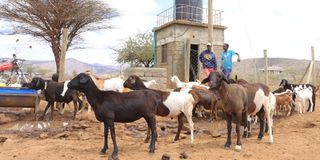The Maasai have a unique culture and outlook on the world, and their methods of animal birth control are no different.
A Maasai man’s stature is determined by the size of his herd but when the births are not timely, it can be disastrous.
For decades, the pastoral community, known for keeping lots of livestock, has tried and tested many ways to control breeding for their goats and sheep. But the traditional ‘condom’ method conspicuously stands out, even today.
In a bid to limit the goat and sheep population during drought or deadly seasonal rainfall, Maasai forefathers improvised their own “animal condom”, called olnjoni or ormeregesh in the Maa dialect.
A rubber or plastic sheath is tied onto the belly of a buck or a ram, behind the fore legs, inches away from the male organ, that acts as a barrier to prevent the animal from mating. The sheath is comfortable for the animal and its elastic material allows the male to sleep on its belly with ease.
The community previously used cowskin but switched to a rubber sheath or a piece of plastic, which is durable and more effective than cowskin.
The traditional birth control is cheap and effective, and is preferred to modern methods, Mr Stephen Nkabashi, 59, a herder in Kajiado Central, told Nation Life&Style on Wednesday. It can be used on a large herd, he added.

A flock of sheep at a watering point at Oloropil village in Kajiado West.
Photo credit: Stanley Ngotho | Nation Media Group
The community also believes the animal remains healthy when the traditional condom is used as no drugs are administered.
“A herder can decide which ram or buck to mate with his herd for continuation of an improved genetic future herd. Instead of castrating the un-preferred animals, the olnjoni is a saviour,” Mr Nkabashi explained.
Herders use the olnjoni to prevent animals from giving birth during the dry or rainy season to prevent deaths of young ones. During mating season, only the preferred male animals will be allowed to mate.
The gestation period for goats and sheep is three months and a single animal can give birth four times annually. A goat or sheep can give birth to more than three lambs a year. Herders usually allow them to breed only two times a year, timing the births to periods when food is plenty.
“Herders prefer their herd to give birth after the heavy rains season or months after short rains when there is enough fodder. If they give birth during the rainy season, most lambs succumb to harsh weather,” Mr Nkabashi said.
But some people have criticised the traditional animal condom method, saying they are “unhygienic” and sometimes a danger to the animals.
Mr Jackson Sinkeet, a farmer in Kitengela, said: “Sometimes the rubber or plastic gets stuck, hurting the animal. When the animal urinates on the sheath, it is exposed to germs, which can block its male organ; it’s easy for an animal to get infections.”
Traditional animal birth control is effective but it sometimes causes animal penis injuries, said Kenya Veterinary Association Council (KVA) chairman Dr Samuel Kahariri.
Dr Kahariri noted that years ago, Western countries introduced anti-mating aprons for sheep and goats, which can be described as improved versions of the olnjoni. But aprons are not common in Kenya.
“The community’s traditional sheath does not have many complications, apart from occasionally hurting the animal’s penis. In future, they might consider using the modern anti-mating apron,” he added.
The olnjoni birth control method is widespread in Kajiado, Narok and parts of Laikipia.

